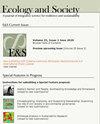比较北极社区对环境变化的适应能力
IF 3.2
2区 社会学
Q1 ECOLOGY
引用次数: 2
摘要
自适应容量(AC)是一个广泛使用的概念,表示人们或系统可以用来应对环境变化的资产或资源。当应用于社区时,仔细定义和测量AC对于识别模式和产生可能对政策有用并可转移到其他地方的结果至关重要。基于与理论的一致性、数据的可用性和可测量的社区差异,我们确定并比较了阿拉斯加北坡八个社区的22项指标。尽管有许多文化和制度上的相似之处,但我们发现,在所测量的七个AC领域中,每个领域的社区之间都存在系统性差异。尽管每个社区在某些领域都有优势,但我们可以根据所有领域的平均排名顺序,将社区分为三组:高整体AC(一个社区)、中等整体AC(四个社区)和低整体AC(三个社区)。我们制定的比较方法有助于确定加强社区AC的生产性政策机会。本文章由计算机程序翻译,如有差异,请以英文原文为准。
Comparing adaptive capacity of Arctic communities responding to environmental change
Adaptive capacity (AC) is a widely used concept denoting assets or resources that people or a system can draw upon to cope with environmental change. When applied to a community, careful definition and measurement of AC is essential for identifying patterns and generating findings that may be useful for policy and transferable to other places. We identified and compared measures of 22 indicators for eight communities on Alaska’s North Slope, based on consistency with theory, availability of data, and measurable community differences. Despite many cultural and institutional similarities, we found systematic differences among communities in each of the seven AC domains measured. Although every community had strengths in some domains, we could divide communities into three groups: high overall AC (one community), moderate overall AC (four communities), and low overall AC (three communities), based on average rank order across all domains. The comparative approach we developed can be helpful in identifying productive policy opportunities for strengthening community AC.
求助全文
通过发布文献求助,成功后即可免费获取论文全文。
去求助
来源期刊

Ecology and Society
环境科学-生态学
CiteScore
6.20
自引率
4.90%
发文量
109
审稿时长
3 months
期刊介绍:
Ecology and Society is an electronic, peer-reviewed, multi-disciplinary journal devoted to the rapid dissemination of current research. Manuscript submission, peer review, and publication are all handled on the Internet. Software developed for the journal automates all clerical steps during peer review, facilitates a double-blind peer review process, and allows authors and editors to follow the progress of peer review on the Internet. As articles are accepted, they are published in an "Issue in Progress." At four month intervals the Issue-in-Progress is declared a New Issue, and subscribers receive the Table of Contents of the issue via email. Our turn-around time (submission to publication) averages around 350 days.
We encourage publication of special features. Special features are comprised of a set of manuscripts that address a single theme, and include an introductory and summary manuscript. The individual contributions are published in regular issues, and the special feature manuscripts are linked through a table of contents and announced on the journal''s main page.
The journal seeks papers that are novel, integrative and written in a way that is accessible to a wide audience that includes an array of disciplines from the natural sciences, social sciences, and the humanities concerned with the relationship between society and the life-supporting ecosystems on which human wellbeing ultimately depends.
 求助内容:
求助内容: 应助结果提醒方式:
应助结果提醒方式:


